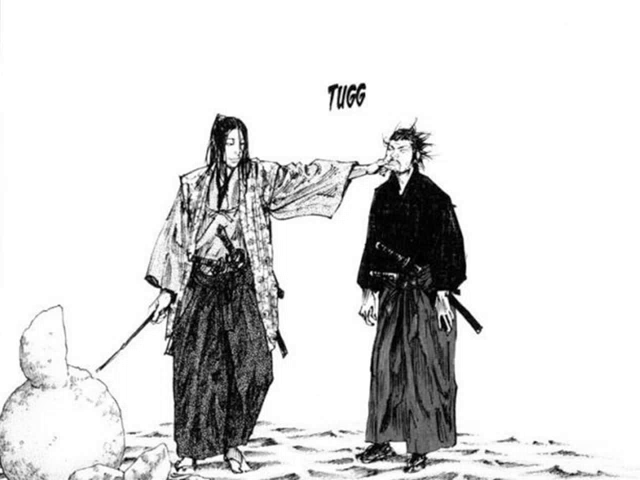Vagabond (1998-present), one of the most beautifully illustrated and almost seamlessly narrated martial arts mangas, comes from the pen of renowned mangaka Takehiko Inoue (Slam Dunk, Real). Vagabond itself is a story about Musashi Miyamoto. This person Musashi actually existed in feudal Japan and people recognize him as a samurai who was undefeated after 61 battles. Instead of his inspiring ‘later life’, Inoue took liberty with his rarely documented ‘early life.
In his specific words, he wanted to tell us a story about, “Young man reaching that point of enlightenment when he comes from a place of being so much like an animal.”
Vagabond pulls no punches showing more fundamental but complex aspects of people such as life& death, the value of human life, and the human condition. There are a lot of different ways that Vagabond tackles this question. Musashi wants to become omnipotent, he wants to manifest his strength and in doing so he challenges every stronger opponent that he can find. It is within this very initial grail and frame-up that we start delving into the idea behind the philosophy of Vagabond which is, “what does it means to be invincible, and does it really matter in the end?”.

But the philosophies of the story reach much deeper than that. These are taught to Musashi along the course of his journey and one of the main focuses is flowing through the circle of life and experiencing you as a part of the entire universe at once. This leads to triumph over the fear of death. “You understand that you are mortal and at some point, this part of you will die but you will continue on in different forms because you will sink into the earth and become part of this universe”. Making this journey through Musashi’s life, one of the most compelling and realistic stories.
At the same time, the story doesn’t focus exclusively on Musashi and instead follows a plethora of different characters. The most notable of them being Matahachi Honiden, Kojiro Sasaki, and Otsu. Other than these, there are a bunch of side characters that come in and out of the story but Vagabond really uses its characters as a vessel to share the ideas and philosophies through them.
Matahachi is the representation of physical, emotional, and spiritual weakness which are essential to be ‘well-managed’ for self-growth. He represents the idea of those people who are afraid to admit their weakness to the world and hence, screw up their life. But as he starts coming out of his shell, his growth, the process of understanding and recognizing the problem that he has, are some of the most profound things about the entire manga.
Vagabond sets up a second protagonist, Kojiro Sasaki who is sort of the embodiment of “going with the flow of universe”. The story takes a great departure from Musashi in order to talk about Kojiro. In fact, the story of his upbringing and his childhood and everything was actually one of the most wholesome and fun things to read about this story. Inouye decided to make him deaf and mute to illustrate the hardship through life with a disability while also demonstrating how his other senses are heightened to the point where he became unrivaled with the sword.

Vagabond, in general, is pure art, it also has one of the best artworks in the manga. It has incredible, jaw-dropping character designs with unique double-page spreads of the downtown streets of Japan, landscape, etc.
Vagabond went on hiatus back in 2015 and not a single chapter has been released ever since. Some wild sequence of events led to several hiatus and thus, we remain in dark about whether this series will ever return. The latest mention about Vagabond from Inouye is as follows, “A few years ago I said Vagabond would end soon but…..I’m Sorry. Manga is a living being that grows along with the characters, whose final destination and evolution is something I never know. So I can’t say when it’s going to end.”
At the current moment, Vagabond doesn’t seem to be getting any chapter soon but years ago he in an exhibition showed us the “ending” of the series, where we see the end of Musashi’s journey as an old man who has picked up his own student now.
Though incomplete, it is considered a masterpiece.
